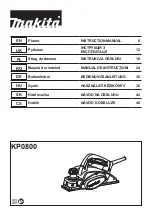
14
| English
1 609 92A 4LF | (26.10.2018)
Bosch Power Tools
The stated vibration level and noise emission value repres-
ent the main applications of the power tool. However, if the
power tool is used for other applications, with different ap-
plication tools or is poorly maintained, the vibration level
and noise emission value may differ. This may significantly
increase the vibration and noise emissions over the total
working period.
To estimate vibration and noise emissions accurately, the
times when the tool is switched off or when it is running but
not actually being used should also be taken into account.
This may significantly reduce vibration and noise emissions
over the total working period.
Implement additional safety measures to protect the oper-
ator from the effects of vibration, such as servicing the
power tool and application tools, keeping their hands warm,
and organising workflows correctly.
Fitting
u
Pull the plug out of the socket before carrying out any
work on the power tool.
Changing the Tool
u
Take care when changing the planer blade. Do not pick
up the planer blade by the cutting edges.
You may be
injured by the sharp cutting edges.
Use only original Bosch HM/TC planer blades.
The hard metal (HM/TC) planer blade has two cutting edges
and can be turned. If both cutting edges become blunt, the
planer blade
(13)
needs to be changed. The HM/TC planer
blade must not be resharpened.
Removing the planer blade (see figure A)
To turn or replace the planer blade
(13)
, turn the blade head
(10)
until it is parallel to the planer base plate
(7)
.
➊
Loosen the two fastening screws
(12)
using the hex key
(14)
(approx. 1–2 turns).
➋
If necessary, loosen the clamping element
(11)
by
lightly striking it with an appropriate implement, e.g. a
wooden wedge.
➌
Use a piece of wood to push the planer blade
(13)
to
the side and out of the blade head
(10)
.
Fitting the planer blade (see figure B)
The guide groove on the planer blade ensures a constant,
even height setting when changing or turning the blade.
If necessary, clean the knife seat in the clamping element
(11)
and the planer blade
(13)
.
When fitting the planer blade, ensure that it is correctly
seated in the mounting guide of the clamping element
(11)
.
The planer blade must be fitted and aligned with the
centre
of the planer base plate
(7)
. Then tighten the two fastening
screws
(12)
with the hex key
(14)
.
Note:
Check that the fastening screws
(12)
are firmly
tightened before starting operation. Turn the blade head
(10)
by hand and ensure that the planer blade is not brush-
ing against anything.
Dust/Chip Extraction
The dust from materials such as lead paint, some types of
wood, minerals and metal can be harmful to human health.
Touching or breathing in this dust can trigger allergic reac-
tions and/or cause respiratory illnesses in the user or in
people in the near vicinity.
Certain dusts, such as oak or beech dust, are classified as
carcinogenic, especially in conjunction with wood treatment
additives (chromate, wood preservative). Materials contain-
ing asbestos may only be machined by specialists.
– Use a dust extraction system that is suitable for the ma-
terial wherever possible.
– Provide good ventilation at the workplace.
– It is advisable to wear a P2 filter class breathing mask.
The regulations on the material being machined that apply in
the country of use must be observed.
u
Avoid dust accumulation at the workplace.
Dust can
easily ignite.
Clean the chip ejector
(3)
regularly. Clean a clogged chip
ejector using a suitable tool, e.g. a piece of wood, com-
pressed air, etc.
u
Do not allow the chip ejector to come into contact with
your hands.
You may be injured by rotating parts.
Always use an external dust extraction device or chip/dust
bag to guarantee optimum suction.
External dust extraction (see figure C)
Connect an extraction hose
(15)
(accessory) to the chip
ejector
(3)
.
Connect the extraction hose
(15)
to a dust extractor (ac-
cessory). You will find an overview of how to connect to vari-
ous dust extractors at the end of these operating instruc-
tions. The dust extractor must be suitable for the material
being worked.
When extracting dry dust that is especially detrimental to
health or carcinogenic, use a special dust extractor.
Self-generated dust extraction (see figure C)
A dust/chip bag (accessory)
(16)
can be used for smaller
jobs. Insert the dust bag nozzle of the chip/dust bag firmly
into the chip ejector
(3)
. Empty the chip/dust bag
(16)
at
regular intervals to maintain optimum dust collection.
Adjustable chip ejector (GHO 26-82 D)
Using the changeover lever
(6)
, the chip ejector can be
(3)
adjusted to the right or left. Always push the changeover
lever
(6)
towards the end position until it clicks into place.
The selected chip ejector direction is indicated by an arrow
symbol on the changeover lever
(6)
.
Operation
Operating modes
Setting the cutting depth
Using the knob
(2)
, the cutting depth can be continuously
adjusted between 0–1.6 mm (GHO 16-82) or 0–2.6 mm















































